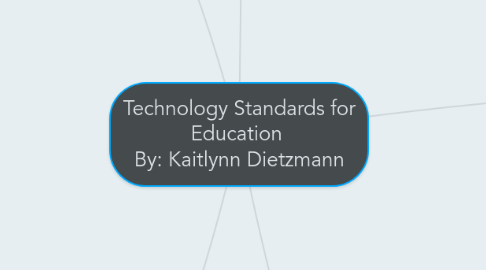
1. CONCEPT #4 PROFESSIONAL LEARNING AND GROWTH
1.1. Learning and Technology Policy Framework
1.1.1. Policy Direction #3: Professional Learning
1.1.1.1. a) Use Data and Research to Inform the Design of Professional Programs
1.1.1.2. b) Use Technology to Provide Options
1.1.1.3. c) School as an Innovative Learning Community
1.2. According to the ISTE Standards for Teachers, Teachers need to be able to be fluent in their use of technology. They can do this in a few ways:
1.2.1. Model Digital Age Work and Learning
1.2.1.1. a) Fluency in Technology
1.2.1.2. b) Collaborate with Students/Peers/Parents/Community
1.2.1.3. c) Relevant Information and Ideas
1.2.1.4. d) Facilitate Effective use of Current and Emerging Digital Tools
1.2.2. Engage in Professional Growth and Leadership
1.2.2.1. a) Participate in Local and Global Communities
1.2.2.2. b) Demonstrate a Vision for Technology
1.2.2.3. c) Evaluate and Reflect Current Research
1.2.2.4. d) Contribute to Vitality of the Teaching Profession
1.2.3. Design and Develop Digital Age Learning Experiences and Assessments
1.2.3.1. a) Design/Adapt Relevant Learning Experiences
1.2.3.2. b) Technology-Enriched Learning Environments
1.2.3.3. c) Personalized Learning Activities
1.2.3.4. d) Various Formative and Summative Assessments
1.3. This can help students to develop in their education of technology as well. Specifically:
1.3.1. Standard #1: Empowered Learner
1.3.1.1. a) Set personal learning goals
1.3.1.2. b) Build networks
1.3.1.3. c) Use technology to seek feedback
1.3.1.4. d) Learn the fundamental concepts of technology operations
1.3.2. Standard #3: Knowledge Constructor
1.3.2.1. a) Employ Effective Research Strategies
1.3.2.2. b) Evaluate the accuracy of Information
1.3.2.3. c) Curate Information
1.3.2.4. d) Build Knowledge
1.3.3. Standard #4: Innovative Designer
1.3.3.1. a) Deliberate Design Process
1.3.3.2. b) Select Digital Tools
1.3.3.3. c) Develop, Test and Refine Prototypes
1.3.3.4. d) Tolerance for Ambiguity
1.3.4. Standard #5: Computational Thinker
1.3.4.1. a) Formulate Problem Definitions
1.3.4.2. b) Collect Relevant Data
1.3.4.3. c) Break Problems into Compact Parts
1.3.4.4. d) Understand How Automation Works
1.3.5. Standard #6: Creative Communicator
1.3.5.1. a) Choose Appropriate Platforms
1.3.5.2. b) Create Original Works
1.3.5.3. c) Communicate Complex Ideas
1.3.5.4. d) Publish or Present Content
2. CONCEPT #5 TAKING EDUCATION OUTSIDE THE CLASSROOM
2.1. ISTE Standards for Students Encourages Students to become.....
2.1.1. Global Collaborators. They can do this by...
2.1.1.1. a) Connect with Learners Through Digital Tools
2.1.1.2. d) Explore Local and Global Issues
2.1.1.3. b) Use Collaborative Technologies
2.1.1.4. c) Contribute Constructively
2.2. In order for students to become global citizens, Schools need to follow the Learning and Technology Policy Framework. For example...
2.2.1. Use Policy Direction #1: Student-Centred Learning
2.2.1.1. a) Establish Vision for Technology
2.2.1.2. b) Develop Coherent Curriculum
2.2.2. Or, use Policy Direction #4: Leadership
2.2.2.1. a) Incorporate Technology to Support Learning
2.2.2.2. b) Update Technology Plans
2.2.2.3. c) Participate in Partnership Opportunities
3. CONCEPT #1 DIGITAL CIIZENSHIP
3.1. According to the ISTE Standards for Students
3.1.1. Students need to become digital citizens by:
3.1.1.1. a) Managing their digital identity
3.1.1.2. b) Engaging in positive, safe, legal and ethical behaviour through the use of technology
3.1.1.3. c) Respecting technology inside and outside of the classroom
3.1.1.4. d) Managing their personal security online
3.2. According to the ISTE Standards for Teachers
3.2.1. Teachers need to promote and model digital citizenship and responsibility by:
3.2.1.1. a) Using technology and information safely, ethically and legally.
3.2.1.2. b) Addressing the diverse needs of all learners
3.2.1.3. c) Promotiong and modeling digital etiquette
3.2.1.4. d) Developing and modeling cultural understanding regarding technology
3.3. According to the ICT Program of Studies
3.3.1. The software that both students and teachers will pursue digital citizenship through are:
3.3.1.1. Word Processers
3.3.1.2. Databases
3.3.1.3. Spreadsheets
3.3.1.4. Draw/Paint/Graphical Applications
3.3.1.5. Internet Browsers
3.3.1.6. Emails
3.3.1.7. Multimedia Applications
3.3.1.8. Clipart/Media Clips
4. CONCEPT #2 DIGITAL LEARNING ENVIRONMENTS
4.1. According to the Learning and Technology Policy Framework
4.1.1. Schoolsneed to have access, infrastructure and digital learning environments. This is completed by:
4.1.1.1. a) Ensuring equitable student access
4.1.1.2. b) Providing access to reliable networks
4.1.1.3. c) Participating in community partnership opportunities
4.1.1.4. d) Ensuring safe network for administration
4.1.1.5. e) Providing high-quality digital learning environments
4.1.1.6. f) Providing timely technical support
4.1.1.7. g) Adopting and maintaining effective practices and up-to-date technological standards
4.2. According to the ISTE Standards for Teachers
4.2.1. Teachers need to facilitate and inspire student learning and creativity. This can be done by:
4.2.1.1. a) Using creative and innovative thinking and inventiveness
4.2.1.2. b) Engaging the students
4.2.1.3. c) Promoting student reflection
4.2.1.4. d) Modeling collaborative knowledge construction
5. CONCEPT #3 USE OF ICT CURRICULUM
5.1. ICT Program of Studies
5.1.1. The ICT curriculum is intended to be used within core courses. It provides techniques to:
5.1.1.1. Gather and identify information
5.1.1.2. Classify and Organize
5.1.1.3. Summarize and Synthesize
5.1.1.4. Analyze and Evaluate
5.1.1.5. Speculate and Predict
5.2. ISTE Standards for Students
5.2.1. The use of the ICT Program of Studies can help students become empowered learners. Students become powered learners by:
5.2.1.1. a) Setting personal learning goals
5.2.1.2. b) Building networks
5.2.1.3. c) Using technology to seek feedback
5.2.1.4. d) Learning the fundamental concepts of technology operations
